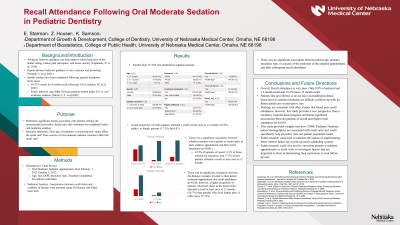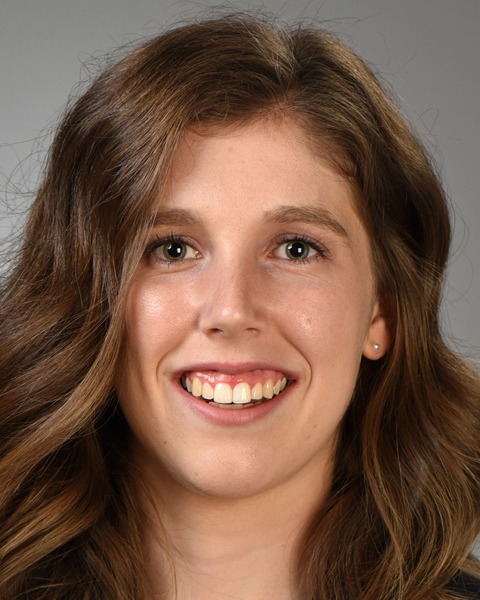Sedation
Recall Attendance Following Oral Moderate Sedation in Pediatric Dentistry Starman E, Houser Z, Samson K University of Nebraska Medical Center, Omaha, NE
442 - Recall Attendance Following Oral Moderate Sedation in Pediatric Dentistry


Emily E. Starman, DDS (she/her/hers)
House Officer II
University of Nebraska Medical Center
University of Nebraska Medical Center
Omaha, Nebraska, United States- ZH
Zachary E. Houser, DMD, MPH
University of Nebraska Medical Center
- KS
Kaeli E. Samson, MPH, MA
University of Nebraska Medical Center
- ZH
Zachary L. Houser, DMD
Program Director
University of Nebraska Medical Center
Omaha, Nebraska, United States
Presenting Author(s)
Co-Author(s)
Program Director(s)
Purpose: Determine significant factors associated with patients seeking recommended preventive dental care after treatment was completed under oral moderate sedation.
Methods: A retrospective chart review of patients treated under oral moderate sedation at UNMC Pediatric Dentistry clinic from February 1st, 2021, to October 1st, 2022. Patient ID, age, sex, date of birth, insurance type, treatment completed, dates of sedation procedure and subsequent dental visits were collected. Recall attendance rate calculated and differences between subgroups assessed using Chi-Square and Fishers exact tests for categorical variables, and Wilcoxon Rank Sum or Kruskal Wallis tests for continuous variables.
Results: One-hundred sixty-nine patients treated under oral moderate sedation were analyzed (N=169). Recall rate for 6 months (±2 months) was 8.9% and for 12 months (±5 months) was 18.3%. 23.7% of patients had at least 1 recall appointment within 18 months of their sedation. Patients who were patients of record prior to their sedation appointment were the most likely to attend a recall in 12 months. There was no significant association between recall attendance rate and patient age; distance traveled; insurance; or treatment completion.
Conclusions: Recall attendance following oral moderate sedation could be an important factor for preventing future dental disease; however, it is difficult to measure or track patient follow-up for patients that do not receive restorative care at their dental home. Knowing the patient demographics of oral sedation patients may help better treat and provide follow-up, preventive dental care.
Identify Supporting Agency and Grant Number: Research supported by the Growth and Development Department of the College of Dentistry at the University of Nebraska Medical Center.

.jpg)